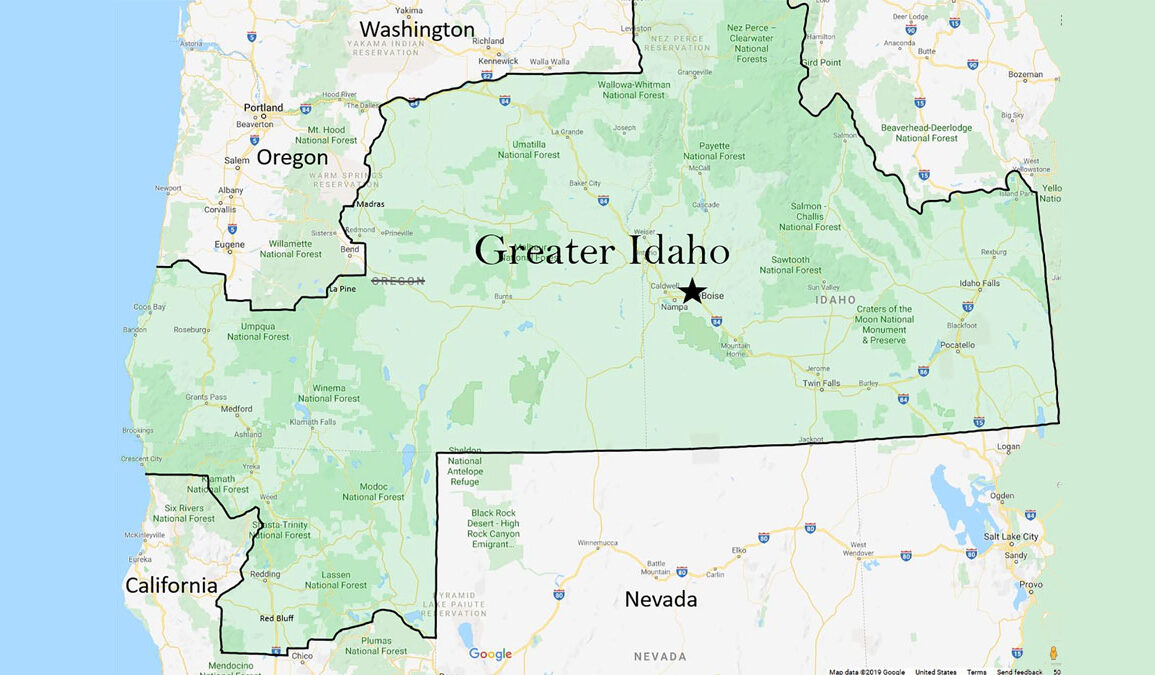For decades, rural counties in eastern Oregon have felt politically alienated from the liberal-leaning western half of the state. Now, a growing grassroots effort—known as the Greater Idaho movement—seeks to redraw the state boundary, shifting about a dozen Oregon counties into Idaho. Supporters argue that this would better align governance with their political and cultural values. But how realistic is this proposal, and what do people on both sides of the political divide think about it?
What is the Greater Idaho Movement?
The Greater Idaho movement aims to shift Oregon’s border, allowing conservative rural counties in the eastern part of the state to become part of Republican-dominated Idaho. Supporters argue that this would better align governance with their political and cultural values.
The movement gained traction in 2020 when the first county-level measures were put to a vote. Since then, 11 counties have approved measures in favor of considering secession. This year, Republican lawmakers in Oregon filed House Bill 3844, which would create a task force to study the implications of moving the border. The bill is currently awaiting committee action.
Proponents argue that both states would benefit. Eastern Oregon residents believe they would have better representation under Idaho’s government, while remaining Oregonians would no longer have to govern a region with vastly different political priorities. “This movement has always been about the people of Eastern Oregon, getting their voice heard and helping those communities get the kind of state-level governance they actually want,” said Greater Idaho president Mike McCarter.
According to Matt McCaw, the executive director of Greater Idaho, “If the Oregon Legislature truly believes in democracy, they will honor those voters’ wishes and move forward on making a border change happen.”
How Close is the Movement to Success?
Despite its momentum, the Greater Idaho movement faces significant legal and political hurdles. Changing a state border is no small task—it requires approval from both state legislatures (Oregon and Idaho) and ultimately, Congress. Historically, such border changes are rare and fraught with complications.
Oregon Governor Tina Kotek, a Democrat, has remained silent on the issue, while Idaho Governor Brad Little, a Republican, has acknowledged the movement’s appeal but noted that the path forward is complex. “I understand why many people want to be Idahoans. They’re looking at Idaho fondly because of our strong economy, regulatory atmosphere, and our values,” Little said in a statement. “Still, there’s a lot that needs to happen before moving the border is within the realm of possibility.”
Critics also point out practical concerns such as taxation, water rights, and differing labor laws. For instance, Idaho has a significantly lower minimum wage ($7.25 per hour) compared to Oregon ($13.50 per hour), raising concerns for workers who would be affected by the transition.
Senator Ron Wyden of Oregon dismissed the idea as “not realistic and has multiple fatal flaws beyond its fundamental implausibility.” He questioned how Oregon landowners’ water rights would fare in Idaho and pointed out that Oregonians moving to Idaho would be required to pay a sales tax, something they have never had to do.
While the idea of secession is gaining more attention, experts suggest that its success remains unlikely. Political scientist Ryan D. Griffiths described the movement as “partly performative,” noting that many secessionist efforts are more about sending a political message than achieving real separation. “It’s a pipe dream, in a way. What they’re doing is partly performative, for ideological purposes,” Griffiths said.
Conservative Perspective: Seeking Representation and Autonomy
Conservatives in eastern Oregon feel ignored by the state legislature, which is dominated by liberal politicians from urban centers like Portland, Eugene, and Salem. Many believe that laws passed in Salem do not reflect their values or economic needs, particularly those affecting agriculture, gun control, and land use.
David Wurdinger, a supporter from Wallowa County, expressed frustration: “Salem won’t listen to ranchers, because there aren’t enough of us left out here.” This sentiment is echoed by others who believe state policies cater disproportionately to Portland and its surrounding areas. Many supporters of Greater Idaho see secession as a peaceful way to resolve the urban-rural divide.
Some also view the movement as a rejection of progressive social policies, including Oregon’s decriminalization of drugs, restrictions on gun ownership, and regulations on businesses. The 2020 COVID-19 restrictions further deepened their resentment, as rural communities felt unfairly subjected to mandates more suited to densely populated cities. McCaw of Greater Idaho summarized this frustration, saying, “We were forced into things we didn’t want and it was all done under the threat of punishment from the western part of the state. That opened a lot of people’s eyes.”
Liberal Perspective: A Dangerous and Divisive Movement
Opponents of Greater Idaho argue that the movement is not just impractical but also exacerbates political and cultural divides. Oregon Senator Ron Wyden dismissed the idea as a “dubious siren song” that fails to consider serious economic consequences.
Critics highlight potential financial and legal issues, such as the loss of Oregon’s sales-tax-free status for residents who move to Idaho. Others warn that redrawing state borders could set a dangerous precedent, encouraging further fragmentation of the country along political lines. Some liberals also worry that the movement has undertones of Christian nationalism, fostering exclusion rather than unity.
Stephen Piggott of the Western States Center, a Portland-based nonprofit, said, “Greater Idaho has been able to capitalize on this to try to further sow divisions. That’s such a drastic step to take. They’re just adding fuel to the flames.”
Can They Do It?
While the Greater Idaho movement has sparked intense debate, the likelihood of eastern Oregon officially joining Idaho remains slim. Even if the Oregon and Idaho legislatures approved the change, Congress would have the final say, and similar proposals have historically failed at the national level.
However, the movement does highlight a growing frustration among rural conservatives who feel politically disenfranchised. As America’s urban-rural divide continues to deepen, discussions like this may become more common, even if they rarely lead to actual border changes.
For now, eastern Oregon remains part of the Beaver State, but the voices calling for a breakaway are growing louder. Whether this effort is a serious political push or simply a protest against liberal governance, the Greater Idaho movement has already succeeded in drawing attention to the state’s deep political divide. As Prineville shop owner Eric Smith put it, “I love Oregon but I just don’t love the people running it right now.”








